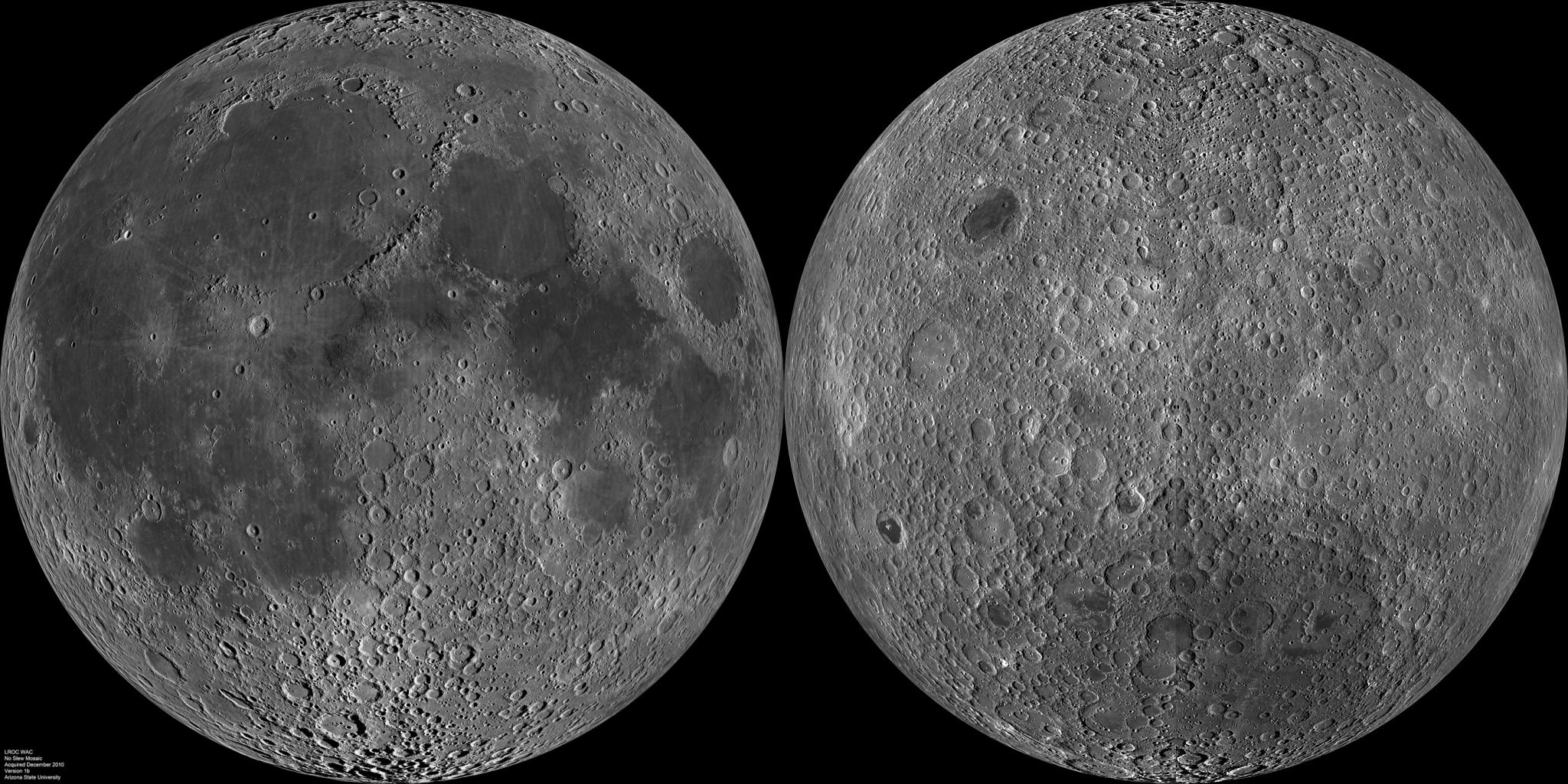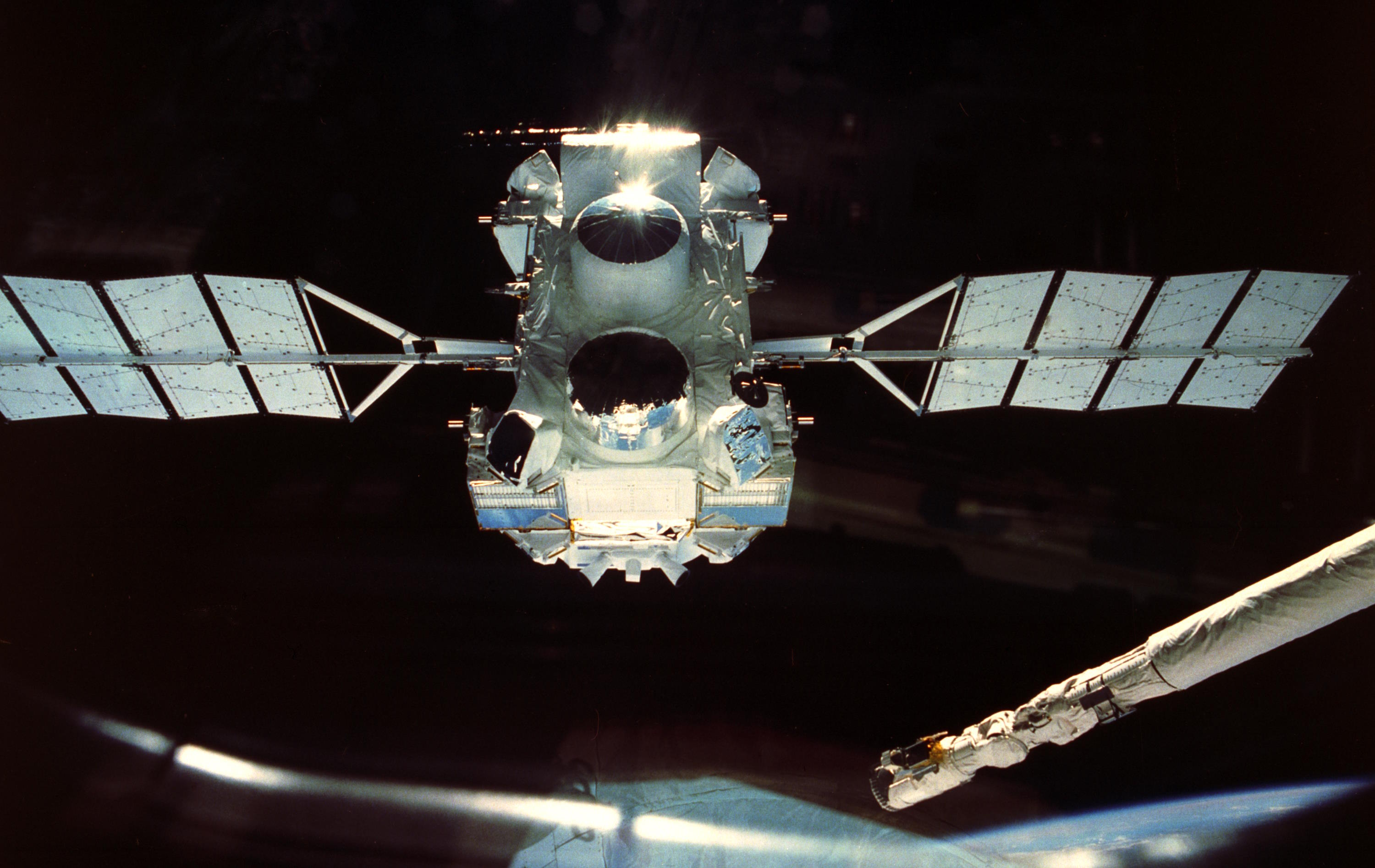We use lasers to keep track of the Moon

- Every month, in its orbit around the Earth, the Moon’s distance from us varies by a tremendous amount: around 40,000 kilometers (25,000 miles).
- Although it was the first object beyond Earth that we ever estimated the distance to, precisely understanding the lunar distance was a big challenge until the 1960s.
- Now, thanks to a series of reflectors that have been physically installed on the Moon, we can keep track of its position to within millimeters. Here’s how it works.
Of all the natural objects located in space, the Moon has long been our nearest cosmic neighbor. We’ve known since ancient times that the Moon is close: closer than the Sun, any of the planets, or any of the stars or nebulae in our night sky. The way we learned that is simply by observing an occultation, where two bodies overlap in the space they appear to occupy as seen from Earth. When the Moon and Sun occupy the same space, we get a solar eclipse, as the (closer) Moon appears to block out the (more distant) Sun. When the Moon and a planet or star occupy the same space, the Moon is always in front, as evidenced by the “dark portion” of the Moon always appearing dark, and never having a planet or star shine in front of it.
But if the Moon is truly our closest neighbor in space, how far away from us is it?
The answer isn’t the same over time, either short-term or long-term. In fact, in the estimated 10 seconds it takes you to read this entire sentence, from start to finish, the Moon’s distance from us has changed by approximately 331 meters (1086 feet). With each revolution around the Earth in its elliptical orbit, the Moon doesn’t return to the same starting and ending point either, but rather recedes from the Earth by an average of 3.1 millimeters per lunar orbit.
Yet, today, we keep track of the Moon more accurately than ever before, thanks to one remarkable technology: lasers. Here’s how we learned the distance to our nearest neighbor in space.

The ancient method
Let’s assume you lived thousands of years ago: before the invention of the laser, the rocket, the camera, the steam engine, or even the Julian calendar. Even if you didn’t understand what gravity was or how it worked, there was still a way to determine — at least approximately — how far away the Moon is from the Earth. All you need to do is watch for two events:
- a solar eclipse (above), so you can prove to yourself that the Moon is, indeed, closer to Earth than the Sun is,
- and then either a partial lunar eclipse or the partial phase of a total lunar eclipse (below), so you can see the shadow of the Earth falling onto the Moon’s surface.
Because you know that the Sun is farther away from the Earth than the Moon is, you can imagine that the shadow of the Earth that you’re seeing on the Moon is approximately the physical size of the Earth. (In reality, it’s a little bit smaller, as the Sun shining on the Earth makes a shadow-cone.) Just by looking at the size of Earth’s shadow falling on the Moon, you can determine how big the Moon is compared to Earth.

The ancient Greeks recorded this measurement, and noted that the Earth’s shadow had a diameter that was about three times the Moon’s diameter. But we already knew how to measure the size of the Earth: Eratosthenes did this way back some 2300 years ago! If we know the size of the Earth, whose diameter is a little less than 13,000 km, then we can estimate the size of the Moon by dividing Earth’s diameter by that factor of three that you can visually see with your eye. For these numbers, 13000/2.5 = 4300 km, which is only about 24% too large.
And if you then know how big the Moon actually is and you measure its angular size on the sky (about half-a-degree), you can use simple geometry to determine how far away the Moon actually is from the Earth: about 493,000 kilometers. (Again, this number is about 24% too large.)
This was the first method ever used to determine how far away the Moon is from the Earth, and it still gives a remarkably good approximation today. But over time, we learned how to measure this distance to even greater precision.

A less ancient method
If you know that the Moon is closer than the stars, then what you can do is have two people stand on Earth, at the same latitude but different longitudes, and both observe the Moon’s relative position to the stars at the same time. In the most extreme case, you can imagine two observers located on completely antipodal points along Earth’s equator looking at the full Moon: one at sunrise/moonset and one at sunset/moonrise. If you can see any points of light at all at that instant — any stars or planets — you can have those two observers measure how the Moon is positioned relative to them.
Because the Moon is closer than any other stars or planets, the Moon will appear to shift between these two observers, just as if you hold your thumb up at arm’s length and switch between your left and your right eye, you’ll see your thumb’s position appear to change relative to the background objects behind it.
If you were to perform this experiment under the ideal conditions, you’d find that the Moon’s apparent position differed by 1.9 degrees between those two observers, which means, for an Earth radius of 6371 kilometers, the Moon would be at a distance of 384,000 kilometers.
This is a great improvement, but there’s a little bit of a problem with only giving one answer like this: the Moon’s distance isn’t constant over time.

If you observe the Moon over the course of a lunar month — the time it takes for the new Moon to wax, become full, wane, and become new again — you’ll notice that it doesn’t remain the same apparent size in the sky. In addition, the “face” of the Moon that you see changes a little bit, too; over the course of a month, you can see more than 50% of the total surface of the Moon: up to a maximum of 59%.
Why?
Because the Moon both revolves around the Earth (in an ellipse) and also rotates on its axis. We normally approximate “one lunar month” as the amount of time it takes the Moon to do both, but in reality, these rates are slightly different. The Moon rotates about its axis at a constant speed, but as it orbits around the Earth, it moves faster when it’s closest to Earth (at perigee) and slowest when it’s farthest from Earth (at apogee).
The Moon’s orbit is actually quite non-circular; at its closest, it gets to within 356,375 km (221,441 miles) of Earth, and at its farthest, it’s as distant as 406,720 km (252,724 miles) from Earth. At its closest, it moves at up to 1.09 km/s relative to Earth, while at its most distant, it only moves at 0.97 km/s relative to Earth. Those differences account for the “wobbling” of the Moon, which is known as lunar libration.

We can see this seasonally, as some months (like July and August in 2023) have full Moons that coincide with lunar perigee, where the Moon appears larger and brighter than normal. We’ve come to call these “supermoons,” where the Moon can be up to 14% larger and 30% brighter than the smallest-appearing full Moons. Conversely, there are also full Moons that either coincide with or come very close to lunar apogee, where the Moon is at its most distant from Earth. We call these full Moons “micromoons,” and those full Moons are the smallest and faintest; the smallest full Moon of 2023 occurred back on February 5th.
As the Moon transitions from perigee to apogee and back again, it moves away from Earth and back toward it. At its swiftest, the Moon can move closer to or farther from Earth at an astounding speed of 270 kilometers-per-hour (168 mph), or a full kilometer closer-or-farther every 13.3 seconds. In as little as six hours, the distance between the Moon and the Earth can change by up to 1,000 kilometers.
Although these changes could have been predicted by the law of gravity since the 17th century, it’s quite another feat to measure these changes directly. But starting in the 1950s, we began to do precisely this.

The first modern method: radar echoing
The idea of radar echoing was that if you send a pulse of radio waves at the Moon, some fraction of those radio waves will bounce off of the Moon and return to you about 2.5 seconds later. After all, radio waves are a form of light, and all forms of light travel at the speed of light, so if you:
- emit a pulse,
- let that pulse bounce off of the Moon,
- and wait for that pulse to return to you,
the time difference of when you emit and receive the return pulse, multiplied by the speed of light, will give you the distance to the Moon. This should come as no surprise to ham radio operators, as bouncing a radio signal off of the Moon (also known as Earth-Moon-Earth or EME communication) is a technique that’s been in use since 1953!
The first experiments using this method were performed in 1946 as part of the US Army’s Project Diana, followed in 1957 by work at the US Naval Research Laboratory. However, they did not give consistent, repeatable results. Those were first obtained in 1958 in the UK, where longer-duration pulses were sent out by the Royal Radar Establishment. This allowed us to measure the lunar distance at any point in time to a precision of just ±1.2 kilometers: the most accurate method until lasers came onto the scene.

The current modern method: lunar laser ranging
However, two things were truly game-changers for measuring the distance to the Moon: the invention and widespread use of the laser, and the ability to land (and install) equipment on the Moon.
Lasers are not only beams of monochrome light, but they’re also highly collimated: a laser beam that shines from Earth spreads out by an extremely small amount. For every kilometer that a laser beam travels, it only spreads out by about 1 centimeter in all directions. Because this light is so coherent and can be “pulsed” over very short time intervals, if only a tiny fraction of the photons emitted can get reflected back to Earth, we can use the round-trip light-travel time to infer the distance to the Moon very accurately.
As part of the Apollo program, several missions (including Apollo 11) involved the installation of lunar retroreflectors: three-dimensional mirrors with corners, made up of many individual cubes, that can reflect light back to whatever source first emitted them. The Soviet Lunokhod programme, which overlapped with the USA’s Apollo, also included laser reflectors. When we fire lasers from Earth and reflect them off of the installed reflectors on the Moon, we can actually measure the distance to the Moon with accuracy of just a few centimeters.

Today, we actually leverage multiple laser-ranging facilities on Earth and the multiple lunar retroreflectors all at once to improve the accuracy incredibly: we can measure the Earth-Moon distance at most times down to precisions of right around a single millimeter, or sometimes even under that value. Considering the average Earth-Moon distance of around 384,400 kilometers, this means we can measure the instantaneous Earth-Moon distance to about 1-part-in-10 billion.
The scientific reasons for this accuracy are many. First off, if you want to land on or orbit the Moon, higher precision and accuracy means smaller errors and less risk of a crash or missed orbit. Detailed observations of how the Moon wobbles and bobbles due to the gravitational influence of the Sun and Earth has shown us that the Moon isn’t a uniform object, but has a liquid core within it. Lunar laser ranging has taught us that Earth’s day varies by a few milliseconds over the course of a year due to the atmosphere, tides, and Earth’s core. It’s also taught us about continental drift, as laser ranging experiments show that the observatory positioned on Maui is drifting away from the observatory in Texas.

With our current precision, we can accurately predict solar and lunar eclipses, including their precise locations and durations on Earth, up to about ~3500 years into both the past and the future. But things aren’t constant over time. Perhaps the most spectacular long-term effect that we’ve noticed is that, over the long-term, the Moon is actually spiraling away from the Earth at a small but significant rate: about 3.8 centimeters-per-year. Additionally, in order to conserve angular momentum, this implies that the Earth’s rate of rotation is gradually slowing down; a full rotation of our planet takes about 2.4 milliseconds longer than it did 100 years ago.
There’s fossil evidence that about 80 million years ago, the length of Earth’s day was about 30 minutes shorter than it is today; there were 372 days in a year and the Moon was about 0.5% closer to us, on average. At its current rate of recession, the Moon will continue to migrate away from Earth and Earth’s rotation will continue to slow down. In another 4 million years, we’ll no longer need leap years on Earth, as a year will have precisely 365 days in it. After ~650 million years, the Moon will be so distant from Earth that total solar eclipses will no longer be possible; the Sun will always appear larger in the sky than the Moon.
By using lasers to keep track of the Moon, we can measure its position, properties, and orbital evolution to greater precision than ever before. With a new array of lunar retroreflectors, we might be able to do even better!





